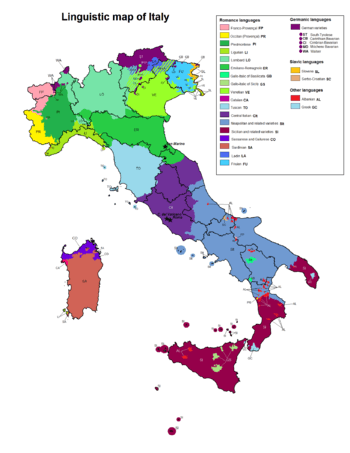Gallo-Italic of Sicily
| Gallo-Italic of Sicily | |
|---|---|
| Italian: Gallo-italico di Sicilia | |
| Native to | Northwest Italy |
| Region | Central and eastern Sicily |
Native speakers | 60,000 (2006)[1] |
|
Indo-European
| |
| Language codes | |
| ISO 639-3 | – |
| Glottolog | None |

The Gallo-Italic of Sicily (Italian: Gallo-italico di Sicilia) is a group of Gallo-Italic varieties found in about fourteen isolated communities in central-eastern Sicily. It forms a language island within the Sicilian language[2][3] and dates back to migrations from Northern Italy during the time of Norman Roger I of Sicily,[4] and which continued under his successors.
The towns that were populated by the new immigrants were to become known as the "Lombard communities" (or Oppida Lombardorum in Latin language, cumuna lummardi in the Sicilian language). In truth, the colonisers, known as "Lombards of Sicily" were not all from today's Lombardy, but most parts of Northern Italy, including Piedmont, Liguria and Emilia—"Lombardy" being the name for the whole of Northern Italy in the Middle Ages. Apart from their geographic origin, the one common attribute that the colonisers had was that they brought with them their Gallo-Italic idioms. These idioms were to add to the Gallic influence of the newly developing Sicilian language (influences which also include Norman and Old Provençal), and have been influenced by Sicilian itself over the centuries creating distinctive Gallo-Italic languages.
History
Although Roger I took 30 years to take complete control of Sicily (1061 to 1091), by 1080 he had effective control over much of the island. In the course of this conquest, large parts of central Sicily became depopulated as the Saracens of the Muslim religion either fled to other Arabic communities that remained intact, or else fled the island entirely in the direction of North Africa. Roger encouraged new migrations to these central parts, in particular, the migrations of Latins who were closely aligned with the Western church. The bulk of the migrations came from Northern Italy. The latter migrations were to provide the vulgar Latin which would form the basis of the new Romance language, while the former migrations would both influence the development of the language profoundly, while at the same time, create altogether unique Gallo-Italic of Sicily idioms in some of the more isolated communities.
Area of diffusion: oppida Lombardorum
The main Gallo-italic languages of Sicily are found in the following towns:
- in the province of Messina: Acquedolci, Montalbano Elicona, Novara di Sicilia, San Fratello and San Piero Patti;
- in the province of Enna: Aidone, Nicosia, Piazza Armerina and Sperlinga.
Other such communities existed also in the provinces of Catania (for example, in Paternò, Bronte and Randazzo), Syracuse (Ferla, Buccheri, Cassaro) and Palermo (Corleone).
Similar communities have survived in part outside of Sicily, in Basilicata, which was subject to similar forces during the same period in question; the particular dialects spoken by those communities are known as "Dialetti gallo-italici di Basilicata".
Bibliography
- F. Piazza, Le colonie e i dialetti lombardo-siculi, Catania, 1921.
- Illuminato Peri, "La questione delle colonie lombarde di Sicilia", BSSS 57, 3-4 (1959), pp. 3–30.
- Giorgio Piccitto, "Testi aidonesi inediti o ignoti", L'Italia dialettale 25, n.s. 2 (1962), pp. 38–100.
- G. Petracco, "Influenze genovesi sulle colonie gallo-italiche delle Sicilia?", BCSic 9 (1965), pp. 106–132.
- Giovanni Tropea, Il vocabolario siciliano manoscritto inedito di Giuseppe Trischitta da Furci Siculo, in: Saggi e ricerche in memoria di Ettore Li Gatti, 3 voll. BCSic [Bollettino del Centro di studi filologici e linguistici siciliani], (Palermo) 6-8 (1962).
- IDEM, "Un dialetto moribondo, il gallo-italico di Francavilla Sicula", BCSic 9 (1965) pp. 133–152.
- IDEM, La letteralizzazione dei dialetti gallo-italici di Sicilia, in: Lingua parlata e lingua scritta, Convegno di studi 9-11 nov. 1967. BCSic 11 (1970) pp. 453–479.
- IDEM, "Effetti della simbiosi linguistica nella parlata gallo-italica di Aidone, Nicosia e Novara di Sicilia", BALI [Bollettino dell'Atlante Linguistico Italiano], n.s. 13-14 (1966), pp. 3–50.
- IDEM, Parlata locale, siciliano e lingua nazionale nelle colonie gallo-italiche della Sicilia, in: Atti del 3° Convegno Nazionale della Cultura Abruzzese; del VI Convegno del CSDI; del 948° Circolo Linguistico Fiorentino. Vol. II: Linguistica. Vol. III: Dialettologia, Pescara, Istituto di Studi Abruzzesi. Abruzzo, Rivista dell'Istituto di Studi Abruzzesi, (Pescara) 8, 1-3 (Gennaio-Dicembre 1970).
- IDEM, "Testi aidonesi inediti", Memorie dell'Istituto Lonmbardo di Scienze, Lettere e Arti, Milano, 33, 5 (1973).
- IDEM, Considerazioni sul trilinguismo della colonia galloitalica di San Fratello, in Dal dialetto alla lingua, Atti del IX Convegno per gli Studi Dialettali Italiani. Lecce, 28 settembre - 1 ottobre 1972. Pisa, Pacini, 1974.
- IDEM, "Italiano di Sicilia", L'Orizzonte, 4, Palermo, Aragne, 1976.
- IDEM, Testi sanfratellani in trascrizione fonetica, in: Vittore Pisani et alii (ed.), Italia linguistica nuova e antica. Studi linguistici in memoria di Oronzo Perlangèli, 2 voll., Università degli Studi di Bari, Facoltà di Magistero, Galatina, Congedo Editore, 1976-1978.
- IDEM, Vocabolario siciliano, fondato da Giorgio Piccitto, 4 voll. Catania-Palermo, Centro di Studi Filologici Siciliani, 1977, 1985, 1990, 1997.
Notes
- ↑ Fiorenzo Toso, Lingue d'Europa: la pluralità linguistica dei paesi europei fra passato e presente, Baldini Castoldi Dalai, Milano 2006, p. 158. (In Italian)
- ↑ Salvatore Carmelo Trovato, La Sicilia, in Cortelazzo et al. I dialetti italiani, UTET, Torino 2002, p. 882. (In Italian)
- ↑ Toso, Fiorenzo (2010). "Gallo-italica, comunità". Enciclopedia dell'Italiano, Treccani, 2010 (in Italian). Treccani.
In Sicilia (Trovato 1998) si tratta dei dialetti di almeno ventiquattro località. Trovato (2002) tuttavia riconosce come ancora schiettamente gallo-italici solo i dialetti che condividono, tra le altre isoglosse settentrionali (➔ isoglossa), la dittongazione in sillaba libera tonica o davanti a palatale di ĕ ed ŏ latino: si tratta delle parlate di San Fratello (con l’ex-frazione di Acquedolci), San Pietro Patti, Montalbano Elicona, Novara di Sicilia (con l’ex frazione di Fondachelli-Fantina) in provincia di Messina; di Randazzo in provincia di Catania; di Nicosia, Sperlinga, Piazza Armerina e Aidone in provincia di Enna; di Ferla, Buccheri e Cassaro in provincia di Siracusa.
- ↑ Ann Katherine Isaacs, Immigration and emigration in historical perspective, Edizioni Plus, Pisa 2007, p, 71.
See also
- Lombard languages
- Western dialects of Lombard language
- Gallo-Italic of Basilicata
- Sicilian language
External links
- Website dedicated to the Gallo-Siculo dialects
- Ethonologue about Western Lombard which include Gallo-Italic of Sicily
| ||||||||||||||||||||||||||||||||||||||||||||||||||||||||||||||||||||||||||||||||||||||||||||||||||||||||||||
